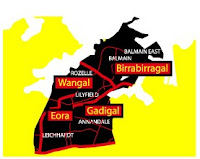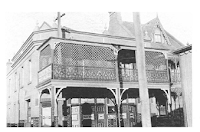 Captain Cook Inn: Nicholson St, Balmain East. The very first hotel on the penninsula, built in 1842. It was only open for 3 years before it became a private residence for Capt. Nicholson (whom Nicholson Street is named after). It later became Durham House but no longer stands.
Captain Cook Inn: Nicholson St, Balmain East. The very first hotel on the penninsula, built in 1842. It was only open for 3 years before it became a private residence for Capt. Nicholson (whom Nicholson Street is named after). It later became Durham House but no longer stands. Rob Roy Hotel: Located at 25 Adolphus St, was a pub for 101 years until 1958. It had a reputation for harbouring unsavoury characters and was known to locals as the "Bloodhouse". It's location serviced the men working on the schooners docked in White Bay and when the drunks spilled out onto the private residence of Shannon Grove (now Ewenton St), the residents - a father and son team known as "The Ward Boys" would eject them, using a revolver. The Rob Roy also had a reputation for selling liquor on Sundays if you went around the back of the hotel. It is now a boarding house.
Rob Roy Hotel: Located at 25 Adolphus St, was a pub for 101 years until 1958. It had a reputation for harbouring unsavoury characters and was known to locals as the "Bloodhouse". It's location serviced the men working on the schooners docked in White Bay and when the drunks spilled out onto the private residence of Shannon Grove (now Ewenton St), the residents - a father and son team known as "The Ward Boys" would eject them, using a revolver. The Rob Roy also had a reputation for selling liquor on Sundays if you went around the back of the hotel. It is now a boarding house.
 Dry Dock Hotel: Is the oldest hotel still operating and is located on the corner of Cameron and College Sts. It opened in 1867 and has been servicing patrons for the last 142 years. It's success has been due to it's location, being close to Mort's Dock and it's innovation. It was the first pub to have a beer garden and live entertainment in Balmain.
Dry Dock Hotel: Is the oldest hotel still operating and is located on the corner of Cameron and College Sts. It opened in 1867 and has been servicing patrons for the last 142 years. It's success has been due to it's location, being close to Mort's Dock and it's innovation. It was the first pub to have a beer garden and live entertainment in Balmain. Royal Oak Hotel: Established in 1878 under the orginial name of Hollis Hotel, the Royal Oak's history is steeped in union connections. In 1887, The Slip, Dock and General Labourers Union was formed at the Royal Oak (then known as Clifford's Hotel). It is one of the few hotels in the area never to have had a verandah. In the old days, the surrounding area was all paddocked with grazing sheep, nowdays, the pub is buried around semi's, terrace houses and unit blocks. The Royal Oak has a great reputation now for an excellent selection of food and wine.
Royal Oak Hotel: Established in 1878 under the orginial name of Hollis Hotel, the Royal Oak's history is steeped in union connections. In 1887, The Slip, Dock and General Labourers Union was formed at the Royal Oak (then known as Clifford's Hotel). It is one of the few hotels in the area never to have had a verandah. In the old days, the surrounding area was all paddocked with grazing sheep, nowdays, the pub is buried around semi's, terrace houses and unit blocks. The Royal Oak has a great reputation now for an excellent selection of food and wine.Davidson, B; Hamey, K; Nicholls, D; Called To The Bar - 150 Years of pubs in Balmain & Rozelle, The Balmain Association, 1991

.jpg)









